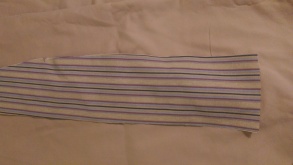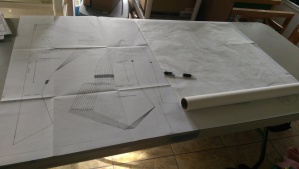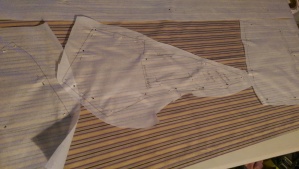Last month I discussed using unusual fabric sources such as curtains, sheets and tablecloths. This month we will start a project using three sheets: a Victorian outfit. For the pattern, I have chosen two Truly Victorian patterns: TV410, 1873 Polonaise and TV221, 1878 Tie-Back Underskirt.
The fabrics are a cotton/polyester mix. For the polonaise, I chose a striped fabric containing a brown base and blue, navy, and purple stripes. The polonaise will be flat lined, a historical method to line a garment and provide structure. More on flat lining later. The lining will be a plain brown fabric. To bring out the light blue stripe, I chose a bright blue for the underskirt.
Next step: tracing the pattern. I don’t think I have a problem yet, but I collect patterns. I have nearly 500 patterns, most of them uncut. If I am lucky enough to have the appropriate size, I can easily trace the pattern. This was the case with the polonaise; the Truly Victorian patterns usually have a wide range of sizes. The polonaise sizes range from a 30” bust to 56”. I buy tracing paper on rolls so I have plenty of it. I realize that the extra step takes time, but it means that I have an uncut
original pattern so I can easily create additional sizes if needed. I also have a tissue paper pattern that I can save and reuse. As a bonus, the created tissue paper pattern is easier to pin on the fabric. Many historical patterns are printed on standard copier weight paper instead of tissue paper. Many pattern companies, such as Simplicity, are offering pattern downloads which will allow you to print a pattern on your own printer using standard weight paper. These patterns may last longer than the standard tissue paper pattern, but they can be more difficult to pin them to the fabric.
Now, I have to warn you, cutting a pattern from a sheet or curtain is not like using commercial fabric. The layout diagram that is included with most commercial patterns will not work
when using sheets and curtains. Those layouts are designed for fabric that is 45” or 60”. It may take a few attempts to fit all the pieces while using the least amount of fabric. It helps if you have a very large table; this will let you lay out the pattern pieces without having to pin them down. After a few attempts, I was able to determine the best layout for the pattern. Here’s a hint: you really want to iron your fabric so that it lays flat in a double layer. This simulates the layout of the commercial fabric so that you have the grain lines aligned, the selvages matched and a fold line for those pieces that need to be cut on a fold. If you are using cotton or a cotton blend, pre-washing the fabric can create quite a few wrinkles and ironing will take care of that.
From this point, it is similar to any other garment construction. You cut the pattern and finish the edges. Because most of our actors are middle school aged, along with middle school size bodies, I chose not to cut out any darts. Children ages 8-14 tend not to have the curves that high school teenagers have and need a straighter cut from the bust to the waist. Eliminating the darts adds a few inches to the waist.
For most period costumes, you will want to flat line. This is particularly true when you are not using a corset or steel bones in the dress. If the production is not a musical and has teenagers, then use a boned corset and/or a boned dress. However, do not recommend this for middle school kids or musicals. Boned garments can be tight and restricting, both of which are an issue for singers and middle school kids. Flat lining the garment with a moderately stiff but thin fabric such as a middle weight cotton or a cotton taffeta. Once again, when at all possible, use natural fibers. The main purpose of a flat lining is to provide additional structure to the garment so that it is less likely to fold or buckle on itself. The fabric lies smoothly against the form. I will not repeat how to flat line but instead direct you to a very good set of instructions where I learned about it. Jennifer Rosbrugh is a costumer and blogger who has thoughtfully included excellent instructions on a number of topic on her blog, including a flat lining tutorial. I have flat lined the bodice but not the over skirt (which is part of the jacket) or underskirt of this particular outfit. Hopefully by next month I will be able to show you the finished product.
Regarding finding period patterns…such patterns are rarely inexpensive, but usually worth it. If it is an original pattern, such as the 1938 Simplicity pattern I recently purchased on ebay, it will only contain one size but it will, without a doubt, be a correct period pattern as it was produced during and for that time period. If it is a recreation, such as the Truly Victorian patterns I am currently using, they usually contain a wide range of sizes with modern instructions and sewing techniques. Buy cautiosly, while on sale, and you will slowly build your pattern library. I keep a list of patterns I want from the large major pattern companies. When those patterns go on sale, whether they are the ‘costume’ patterns or historically recreated patterns, I have a ready list of what I want to buy. My local Hancocks and Joanns frequently has sales for McCalls, Butterick, and Simplicity that allow you to purchase 5 patterns for $10 dollars, which brings the pattern to a mere $2 a piece. Vogue will lower their price to 2 for $10 which brings it to the manageable price of $5. It is rarely necessary to pay full price for period patterns.
Additional resources for historical costuming:
Reconstructing History Patterns
Also, be sure to check ebay.com for good deals (in particular a lot of multiple period patterns) and pinterest.com for free online patterns.


